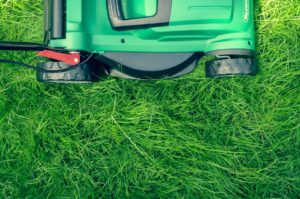
Continue to trim your grass until winter.
Most lawns don’t require much care in the winter. However, that doesn’t mean you should neglect your landscape when the weather turns cool. With some pre-winter prep work, you can help ensure that your lawn survives the winter and comes back green and healthy in the spring. Late fall is the optimal time to start preparing your lawn for the chilly winter season ahead.
Continue to Mow Your Lawn
Your grass will usually continue growing until the temperature dips below 50 degrees Fahrenheit. Ideally, you want to continue mowing your lawn until you experience the first frost of the season. As grass growth can slow, you want to gradually reduce the blade height after each mow. By winter, your lawn should be about 2 to 2.5 inches high.
Keep Your Lawn Hydrated
Water is needed to help protect your lawn year-round. However, your lawn needs less water in the winter to keep it healthy. Water your lawn right before cold temperatures arrive to help protect it from frost damage. Water your lawn in the morning to give the roots plenty of absorption time. Avoid watering your lawn at night, as this can cause fungus to grow due to water retention.
Aerate and Fertilize Your Lawn
Aerate your lawn just before the first expected frost date. Lawn aeration creates small holes in the soil, which allows water, nutrients, and oxygen to penetrate to the grass roots. Aerating your lawn just before winter gives your turf a chance to breathe before it goes dormant. After aerating your lawn, take the time to add a quality fertilizer. Fertilizer provides your grass with the vital nutrients it needs for winter.
Remove Fallen Leaves
Layers of fallen leaves can become wet and heavy, causing your grass to suffocate. Moisture trapped between the grass and leaves also encourages the growth of various fungal diseases. Before winter hits, take the time to rake up and bag the leaves in your yard. If you discover signs of fungal disease, treat your yard with a fungicide or try an organic treatment like neem oil or compost tea.
Fill in Bald Spots
Bald spots in your yard can develop for a number of reasons, such as fungi, insects, pet urine, or heavy foot traffic. After the hot summer season is over, take the necessary steps to fill in bald spots. Start by roughing up the soil with a cultivator and dethatching if necessary. Spread a layer of compost over the lawn to create a bed for new seeds. Sow the new seeds and cover them lightly with more compost.
Keep Mosquitoes at Bay
The perfect breeding temperature for mosquitoes is about 50 degrees Fahrenheit. Before the weather begins to cool, be sure to remove anything in your yard that could hold stagnant water, as this is where mosquitoes prefer to breed.
Apply Topdressing on Low Areas
Adding topdressing made up of a thin layer of soil over your lawn can help improve soil without harming the grass. Topdressings can be especially useful in low areas of your landscape caused by erosion or rotting tree roots. Add the topdressing in the fall, giving your grass time to go through at least another three or four mowings before colder weather arrives.
